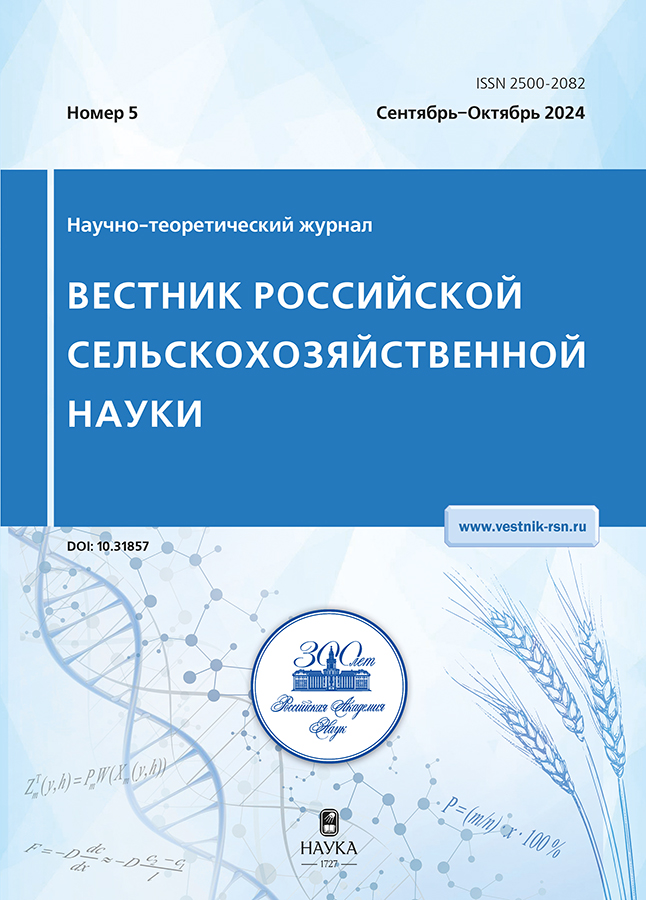Influence of mineral fertilizers and liming on the dynamics of CO2 emissions, crop yield and quality of crop products of crop rotation link
- Authors: Svirina V.A.1, Chernogaev V.G.1
-
Affiliations:
- The Institute of Seed Production and Agrotechnologies- branch of the FSBSI Federal Scientific Agroengineering Center VIM
- Issue: No 5 (2024)
- Pages: 45-50
- Section: Crop Production and Selection
- URL: https://archivog.com/2500-2082/article/view/659246
- DOI: https://doi.org/10.31857/S2500208224050106
- EDN: https://elibrary.ru/ztefvu
- ID: 659246
Cite item
Abstract
In the field experiment was investigated the effect of repeated lime application on CO2 emissions from the soil, yield and quality of plant products against the background of mineral fertilizers N90P90K90, on dark gray forest heavy loamy soil. As a result of liming and improvement of the acid regime in the soil, prerequisites are created to enhance the vital activity of beneficial microorganisms in the experiment. It was revealed that an increase in biological activity (carbon dioxide emissions) against the background of the application of mineral fertilizers N90P90K90 and CaCO3 ensures high yield and product quality, contributes to favorable conditions for preserving soil fertility and to a greater extent stimulates the development of microorganisms using mineral forms of nitrate nitrogen. With the systematic use of mineral fertilizers N90P90K90 at the stage of crop rotation, an increase in the quality of cultivated crops was noted (the nutritional value of the green mass of clover; the content of crude protein, protein, gluten, starch in barley grain; the nature of grain in winter wheat). In different years of research, according to weather conditions, grain with a high content of crude gluten, protein, nature in winter wheat grain, starch in barley, ash nutrition elements in clover was obtained. The best option turned out to be using dolomite flour and (N90P90K90). All the considered quality indicators of winter wheat improved under the influence of fertilizers and lime, and the difference with the control was: protein – 0,64–1,78%; crude gluten – 1,6–4,3%; grain nature – 11–26 g/l. The highest productivity was obtained when applying mineral fertilizers and lime: barley – 3,53 t/ha, clover hay of the first year of use – 77,53 t/ha, winter wheat – 7,89 t/ha, compared with the control without the use of fertilizers.
Full Text
About the authors
V. A. Svirina
The Institute of Seed Production and Agrotechnologies- branch of the FSBSI Federal Scientific Agroengineering Center VIM
Author for correspondence.
Email: svirina-vera@mail.ru
Senior Researcher
Russian Federation, Podvyazye village, Ryazan regionV. G. Chernogaev
The Institute of Seed Production and Agrotechnologies- branch of the FSBSI Federal Scientific Agroengineering Center VIM
Email: svirina-vera@mail.ru
Junior Researcher
Russian Federation, Podvyazye village, Ryazan regionReferences
- Ahmetzyanov M.R., Talanov I.P. Vliyanie priemov osnovnoj obrabotki pochvy i rastitel’noj biomassy na produktivnost’ kul’tur v zvene sevooborota // Plodorodie. 2019. № 5 (110). S. 41–45. EDN: WGYZER. https://doi.org/10.25680/S19948603.2019.110.12
- Gladysheva O.V., Pestryakov A.M., Svirina V.A., Krasnikov N.G. Izvestkovanie dlya uluchsheniya plodorodiya temno-seroj lesnoj pochvy // Vestnik Rossijskoj akademii sel’skohozyajstvennyh nauk. 2014. № 6. S. 26–27. EDN: SYJUWB.
- Golosnoj E.V., Ageev V.V., Podkolzin A.I. Vliyanie sistem udobrenij na urozhajnost’ i kachestvo kul’tur zvena sevooborota na chernozeme vyshchelochennom Stavropol’skoj vozvyshennosti // Agrohimicheskij vestnik. 2013. № 2. S. 33–35. EDN: RDUQVH.
- Dospekhov G.A. Metodika polevogo opyta. M.: Agropromizdat. 351 s.
- Kanukov Z.T., Dzanagov S.H., Basiev A.E. i dr. Urozhaj i kachestvo produkcii kul’tur sevooborota pri udobrenii vyshchelochennogo chernozema // Plodorodie. 2009. № 4 (49). S. 41–42. EDN: KYVSUV.
- Leshkenov A.M., Zanilov A.H., Krylova M.F. Vliyanie biologicheskoj aktivnosti pochvy na soderzhanie organicheskogo veshchestva na fone vozrastayushchih doz mineral’nyh udobrenij // Zemledelie. 2022. № 7. S. 11–15. EDN: OZFKQO. https://doi.org/10.24412/0044-3913-2022-7-11-15
- Lomako E.I., Aliev Sh. A. Izvestkovanie pochv Respubliki Tatarstan. Kazan’: OOO “Centr innovacionnyh tekhnologij”, 2004. 272 s. EDN: XGJBFZ.
- Matyuk N.S., Polin V.D., Shevchenko V.A., Solov’ev A.M. Aktivnost’ mikroorganizmov dernovo-podzolistoj pochvy v razlichnyh agroekosistemah // Plodorodie. 2020. № 2 (113). S. 61–64. EDN: VRPUDG. https://doi.org/10.25680/S19948603.2020.113.18
- Mineev V.G. i dr. Praktikum po agrohimii. M.: Izd. MGU, 2001. 689 s.
- Naliuhin A.N., Vlasova O.A., Eregin A.V. i dr. Produktivnost’ polevogo sevooborota pri razlichnyh sistemah udobreniya i izvestkovanii // Plodorodie. 2020. № 4 (115). S. 30–34. EDN: ETLXSL. https://doi.org/10.25680/S19948603.2020.115.09
- Fedorova A.V., Bahvalova S.A., Dem’yanova-Roj G.B. Vliyanie azotnyh udobrenij na urozhajnost’ i kachestvo zerna ozimoj pshenicy // Plodorodie. 2022. № 5(128). S. 30–32. EDN: UQEZFE. https://doi.org/10.25680/S19948603.2022.128.08
- Chuhina O.V., Surov V.V., Tokareva N.V., Anfimova S.L. Kachestvo i urozhajnost’ kul’tur zvena sevooborota pri primenenii udobrenij i mikrobiologicheskih preparatov v Vologodskoj oblasti // Plodorodie. 2015. № 1 (82). S. 25–29. EDN: THJMGV.
- Holland J.E., White P.J., Glendining M.J. et al. Yield responses of arable crops to liming – An evaluation of relationships between yields and soil pH from a long-term liming experiment, European Journal of Agronomy. 2019. Vol. 105. P. 176–188. https://doi.org/10.1016/j.eja.2019.02.016
- Li Y., Cui S., Chang S.X. et al. Liming effects on soil pH and crop yield depend on lime material type, application method and rate, and crop species: a global meta-analysis. J Soils Sediments 19. 2019. Р. 1393–1406. https://doi.org/10.1007/s11368-018-2120-2.
Supplementary files










